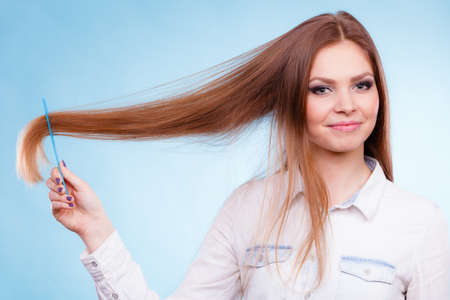What Are Keratin Treatments?
Keratin treatments have become a buzzword in the world of American hair care, offering a solution for anyone looking to achieve sleek, manageable hair. But what exactly are keratin treatments, and how do they work? At their core, keratin treatments are salon services designed to smooth and straighten hair by infusing it with a specialized formula rich in keratin protein—the same natural protein found in your hair, skin, and nails. The treatment process typically involves applying the keratin product to clean hair, then sealing it in with heat from a flat iron. This not only tames frizz but also adds shine and makes daily styling much easier.
The history of keratin treatments in the United States dates back to the early 2000s, when they were introduced as an innovative alternative to traditional relaxers and straightening methods. Initially popularized in Brazil, these treatments quickly gained traction among American salons due to their ability to deliver long-lasting results without harsh chemicals. Today, keratin treatments are considered a staple service for those wanting smoother, healthier-looking hair—especially in humid climates where frizz is a constant battle. As you explore this guide, youll get a comprehensive look at the benefits, potential risks, and maintenance tips that come with this transformative hair care solution.
Key Benefits of Keratin Treatments
Keratin treatments have become a go-to solution for many Americans looking to achieve smoother, more manageable hair. Let’s break down the practical advantages that make these treatments so popular across diverse hair types.
Frizz Control and Smoothing Effects
One of the main reasons people turn to keratin treatments is their unmatched ability to tame frizz, especially in humid climates typical in parts of the U.S. The treatment seals the hair cuticle, reducing puffiness and flyaways, resulting in a sleek, polished look.
Styling Ease and Time Savings
After a keratin treatment, daily styling becomes significantly easier. Many find they can cut their blow-drying or flat-ironing time by half or more. This is a huge benefit for busy professionals or parents juggling multiple responsibilities.
Consistent Results Across Hair Types
Keratin treatments are versatile and work on straight, wavy, curly, and coily hair. While results may vary based on texture and previous chemical processes, most people notice enhanced shine, silkiness, and manageability. Here’s a quick overview:
| Hair Type | Typical Result |
|---|---|
| Straight | Sleeker finish, reduced static |
| Wavy | Smoother waves, less frizz |
| Curly | Looser curls, easier detangling |
| Coily/Kinky | Softer texture, improved manageability |
Long-Lasting Effects with Proper Maintenance
A properly applied keratin treatment can last anywhere from 6 weeks to 5 months, depending on aftercare routines and individual hair characteristics. This means less time spent worrying about unpredictable hair days and more time enjoying consistent results.

3. Potential Risks and Side Effects
While keratin treatments are popular for their smoothing and frizz-reducing effects, it’s crucial to understand the potential risks and side effects before booking your appointment. One of the main concerns is chemical exposure, especially to formaldehyde or formaldehyde-releasing agents used in many formulas. Prolonged inhalation during the treatment process can cause irritation of the eyes, nose, and throat, and may be particularly risky for salon professionals who perform these services regularly.
Chemical Exposure Concerns
Formaldehyde is classified as a human carcinogen by agencies like OSHA and the CDC. Even “formaldehyde-free” products sometimes contain ingredients that release this gas when heated with flat irons. Proper ventilation and protective measures are essential in salons, but at-home kits may not offer adequate safeguards. Always check ingredient lists and ask your stylist about safety protocols.
Hair Damage
Despite their promise of healthier-looking hair, repeated keratin treatments can actually weaken hair structure over time. High heat from flat irons (often above 400°F) is required to seal in the treatment, which can lead to dryness, breakage, or split ends—especially if your hair is already damaged or chemically processed. Over-processing may also strip natural oils, leaving hair brittle.
Considerations for Different Hair Types
Keratin treatments are not one-size-fits-all. For fine or thin hair, results can range from added shine to excessive limpness or even increased shedding. Those with color-treated or bleached hair should proceed cautiously, as pre-lightened strands are more susceptible to damage. On the other hand, individuals with coarse or highly textured hair may benefit most from reduced frizz but still face similar risks if treatments are done too frequently.
Lesser-Known Risks
Some clients report allergic reactions such as scalp redness or itching. Others notice changes in curl pattern that don’t revert after several months. It’s also worth noting that pregnant or breastfeeding individuals are generally advised to avoid keratin treatments due to limited research on fetal and infant safety. If you have underlying respiratory issues like asthma, consult your doctor before proceeding.
Understanding these risks empowers you to make an informed decision and take necessary precautions—whether you’re visiting a professional salon or trying a DIY kit at home.
4. Keratin vs. Other Smoothing Treatments
When it comes to smoothing and straightening hair, keratin treatments arent the only game in town. US salon-goers often consider alternatives like Brazilian blowouts and Japanese hair straightening (thermal reconditioning). Each method has distinct benefits, risks, and maintenance requirements. Understanding these differences can help you choose the best option for your hair goals and lifestyle.
Main Differences Between Popular Smoothing Treatments
| Treatment Type | Key Ingredients | Results | Longevity | Best For | Downtime |
|---|---|---|---|---|---|
| Keratin Treatment | Keratin protein, formaldehyde or formaldehyde alternatives | Smoother, less frizzy, manageable; not fully straight | 3-5 months | Frizz control, wavy/curly hair wanting softness & shine | No washing/tight hairstyles for 48-72 hours post-treatment |
| Brazilian Blowout | Amino acids, proprietary smoothing complex (often contains formaldehyde) | Smooths frizz, keeps natural wave/curl if desired; customizable finish | 10-12 weeks | Quick results, versatile styling options, humidity resistance | No downtime—can wash and style same day |
| Japanese Straightening (Thermal Reconditioning) |
Thio-based chemicals, heat activation | Permanently straightens hair until new growth appears; very sleek look | 6+ months (until regrowth) | Tightly curled/kinky hair seeking pin-straight finish | Avoid tying up/washing for 72 hours; longer salon appointment required |
What Sets Keratin Apart?
Chemistry & Results: Keratin treatments infuse your hair with proteins that reinforce its structure without completely breaking down the natural bonds. This means you keep some body and movement—unlike Japanese straightening, which delivers ultra-sleek, flat results by restructuring bonds permanently.
Flexibility: Many clients appreciate that keratin and Brazilian blowout services allow them to maintain waves or curls if they want, just with added smoothness and reduced frizz. Japanese straightening is best for those who want a dramatic change to stick-straight strands.
Safety Considerations & Upkeep
If youre sensitive to chemicals or concerned about formaldehyde exposure, its important to talk with your stylist about product formulations—some salons offer low-formaldehyde or alternative smoothing systems. Maintenance routines also vary: Keratin treatments typically require sulfate-free shampoos and gentle care to extend longevity, while Japanese straightening requires root touch-ups every few months as new textured growth appears.
The Bottom Line for US Salon-Goers
Your ideal smoothing treatment depends on your desired look, commitment to upkeep, and comfort with chemical processes. Discuss your goals honestly with your stylist—they can recommend the safest and most effective solution based on your hair history and lifestyle needs.
5. Maintenance Tips for Long-Lasting Results
Choose the Right Hair Products
To maximize the lifespan of your keratin treatment, it’s crucial to use sulfate-free and sodium chloride-free shampoos and conditioners. These gentle formulas prevent stripping away the keratin coating, helping your hair stay smoother for longer. Look for American brands like Pureology or Living Proof, which are widely available and specifically formulated to protect treated hair.
Adjust Your Washing Routine
Avoid washing your hair daily—two to three times a week is ideal. Over-washing can shorten the effects of your treatment. When you do wash, use lukewarm water instead of hot water, as high temperatures can weaken the keratin bond.
Protect Your Hair When Styling
Minimize heat styling tools like flat irons and curling wands whenever possible. If you must use them, always apply a heat protectant spray beforehand. Air drying is best for maintaining healthy, treated hair.
Embrace Gentle Brushing
Use a wide-tooth comb or a soft-bristle brush to detangle your hair gently, starting from the ends and working your way up. This prevents breakage and maintains the smoothness provided by your treatment.
What to Avoid After Treatment
Skip swimming in chlorinated pools or saltwater for at least two weeks after your keratin treatment—these environments can strip away keratin quickly. Also, avoid tight ponytails or hair accessories that might cause creasing in the first few days post-treatment.
Regular Salon Visits
Schedule follow-up appointments every 3-5 months depending on your hair growth and lifestyle. Professional touch-ups help maintain optimal results and keep your hair looking its best year-round.
6. What to Expect at a US Salon
A Step-by-Step Walkthrough of the Keratin Treatment Experience
If you’re considering a keratin treatment in the US, knowing what to expect can help you feel more confident and prepared. Most American salons follow a standardized process designed for both comfort and results. Here’s how your appointment will typically unfold:
Consultation and Hair Assessment
Your stylist will begin with a thorough consultation, discussing your hair history, texture, and expectations. Be honest about any previous chemical treatments or color services. This is also your chance to ask about the specific type of keratin treatment they offer—some salons use traditional formulas, while others opt for “formaldehyde-free” versions.
The Application Process
After washing your hair with a clarifying shampoo, the stylist will apply the keratin solution section by section. The product is then sealed into your hair using a flat iron at a high temperature. Depending on your hair’s length and thickness, this process can take anywhere from 1.5 to 3 hours.
Post-Treatment Instructions
Once the treatment is complete, many stylists recommend waiting 24-72 hours before washing your hair or using styling products. Your stylist should provide detailed aftercare instructions specific to their product line—don’t hesitate to request written guidelines.
Pricing Expectations Across US Salons
Keratin treatments in the United States vary widely in cost based on location, salon reputation, and stylist experience. On average, you can expect to pay between $150 and $400 per session. High-end salons in cities like New York or Los Angeles may charge upwards of $500. Some salons offer express keratin services at lower prices but with shorter-lasting results.
Key Questions to Ask Your Stylist
- Which brand or type of keratin treatment do you use?
- Is this formula formaldehyde-free?
- How long will my results last based on my hair type?
- Are there any maintenance products I should use at home?
- What should I avoid post-treatment (e.g., swimming, certain shampoos)?
Remember, open communication with your stylist ensures that the treatment aligns with your hair goals and lifestyle. Don’t be afraid to advocate for your needs—US salons are accustomed to client questions and expect an interactive dialogue during your appointment.
7. Who Should (and Shouldnt) Get a Keratin Treatment?
Keratin treatments have become a staple in many American salons, but theyre not one-size-fits-all. Understanding your hair type, lifestyle, and beauty goals is essential before making the investment.
Who Benefits Most from Keratin Treatments?
If you struggle with frizz, spend too much time blow-drying, or love sleek, manageable hair, keratin could be a game-changer. It’s ideal for those with wavy or curly hair who want to reduce styling time and achieve smoother results. Professionals with busy schedules and parents juggling family demands often appreciate the “wash-and-go” simplicity keratin can offer.
Hair Types That Respond Well
- Curly/Wavy Hair: Tames curls and waves for easier styling without erasing natural texture.
- Thick/Coarse Hair: Reduces volume and makes hair more manageable.
- Color-Treated Hair: Can enhance shine and protect color when done correctly (choose formaldehyde-free formulas).
When to Think Twice
Keratin isn’t for everyone. If you have fine, thin, or severely damaged hair, the chemicals and heat involved might do more harm than good. Also, anyone sensitive to ingredients like formaldehyde—or those committed to all-natural routines—should avoid traditional keratin treatments. Pregnant women are generally advised to skip these treatments due to chemical exposure risks.
Lifestyle Considerations
- If you swim frequently (chlorine and salt water strip keratin faster), results may not last long.
- If you love changing hairstyles often or embrace your natural curls, consider if straightening aligns with your self-expression.
Final Advice: Match Your Needs
The latest trends in American haircare emphasize personalization. Consult with a trusted stylist who understands your hair’s unique needs and your daily routine. Weigh the pros and cons honestly—sometimes a smoothing treatment is perfect for summer humidity or special events; other times, embracing your natural texture is the healthiest choice. Make sure any decision fits your lifestyle for maximum satisfaction and hair health.


